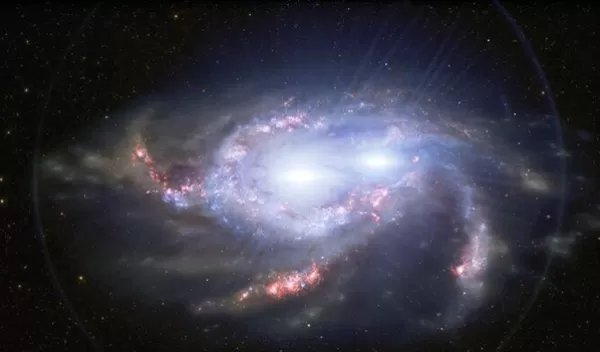
Black hole pairs found in distant merging galaxies
Astronomers have found two close pairs of quasars in the distant universe. The quasars are closer together than any pair of quasars found so far away, providing strong evidence for the existence of supermassive black hole pairs as well as insights into galaxy mergers in the early universe.
The results are published in Nature Astronomy.
Quasars are the intensely bright cores of distant galaxies, powered by the feeding frenzies of supermassive black holes. These energetic objects profoundly affect galaxy formation and evolution, making observations of quasar pairs in the early universe a unique way for astronomers to investigate the evolution of merging galaxies. Quasar pairs also provide a natural laboratory in which to study the processes leading to the formation of binary supermassive black holes.
Finding the two quasar pairs was a daunting challenge, requiring a new method that combined data from several space and ground-based telescopes, including the U.S. National Science Foundation-funded Gemini Observatory of the NOIRLab.
The quasars in each of the two pairs are separated by just over 10,000 light-years, suggesting that they belong to two merging galaxies. Double quasars are scientifically interesting but rare objects -- particularly in the most distant reaches of the universe -- and these are the most distant quasars found that are so close together. The quasar pairs are seen as they existed roughly 10 billion years ago.
To focus their search, the researchers first identified 15 quasars for further investigation using the Sloan Digital Sky Survey, a three-dimensional map of objects in the night sky. From this list of 15 quasars, they then used observations from the Gaia spacecraft to identify four potential quasar pairs. Finally, these candidates were imaged with the Hubble Space Telescope, which visually resolved two quasar pairs.
The team then used the Gemini Multi-Object Spectrograph on Gemini North, located on Maunakea in Hawaii, to verify the discovery and further investigate one of the quasar pairs.
"This exciting investigation illustrates yet again the discovery potential of combining archived survey data with new, focused observations from state-of-the-art facilities," said Martin Still, a program director in NSF's Division of Astronomical Sciences. "The international Gemini Observatory proved to be the ideal instrument to confirm the identity of these black holes and characterize their environment."


